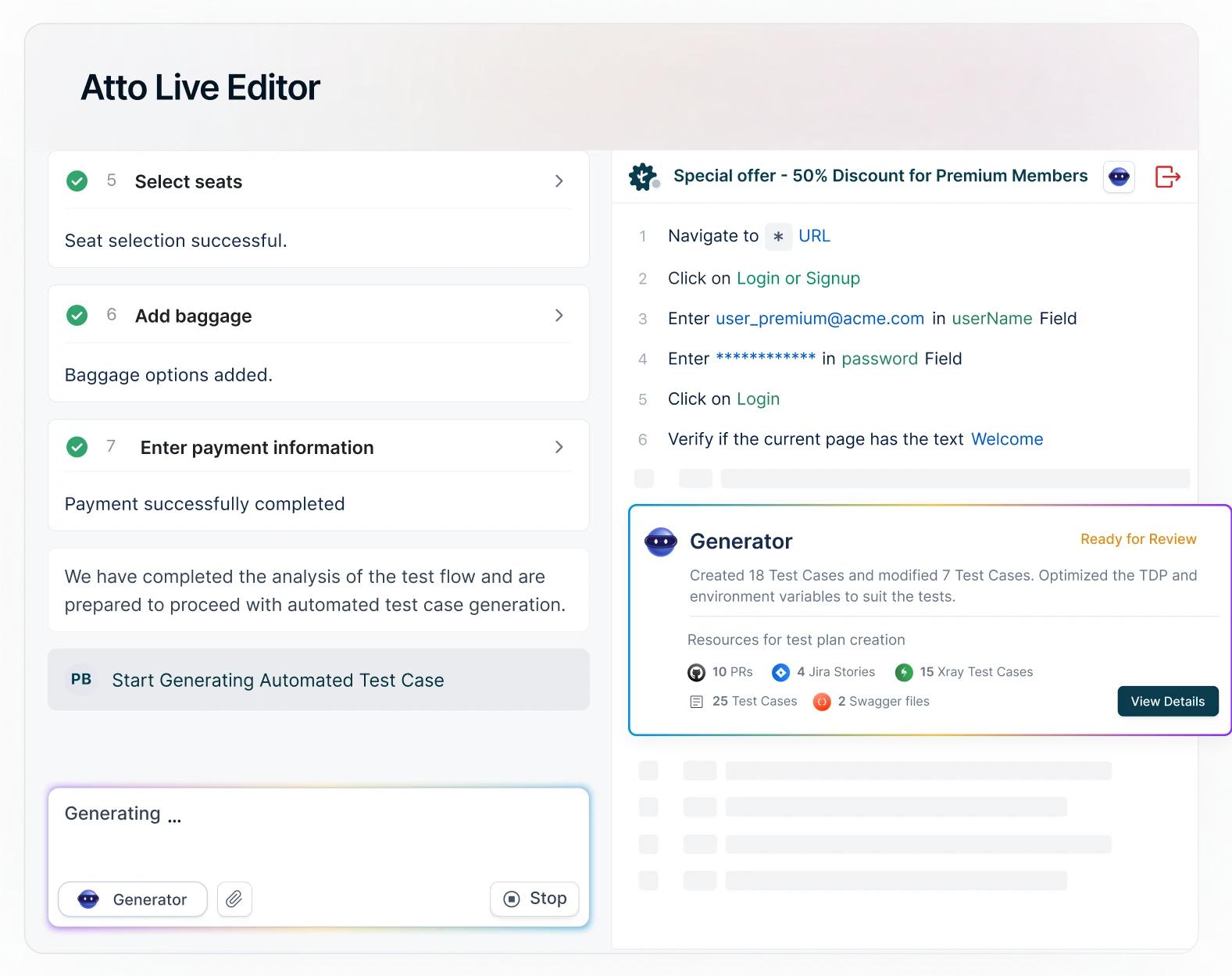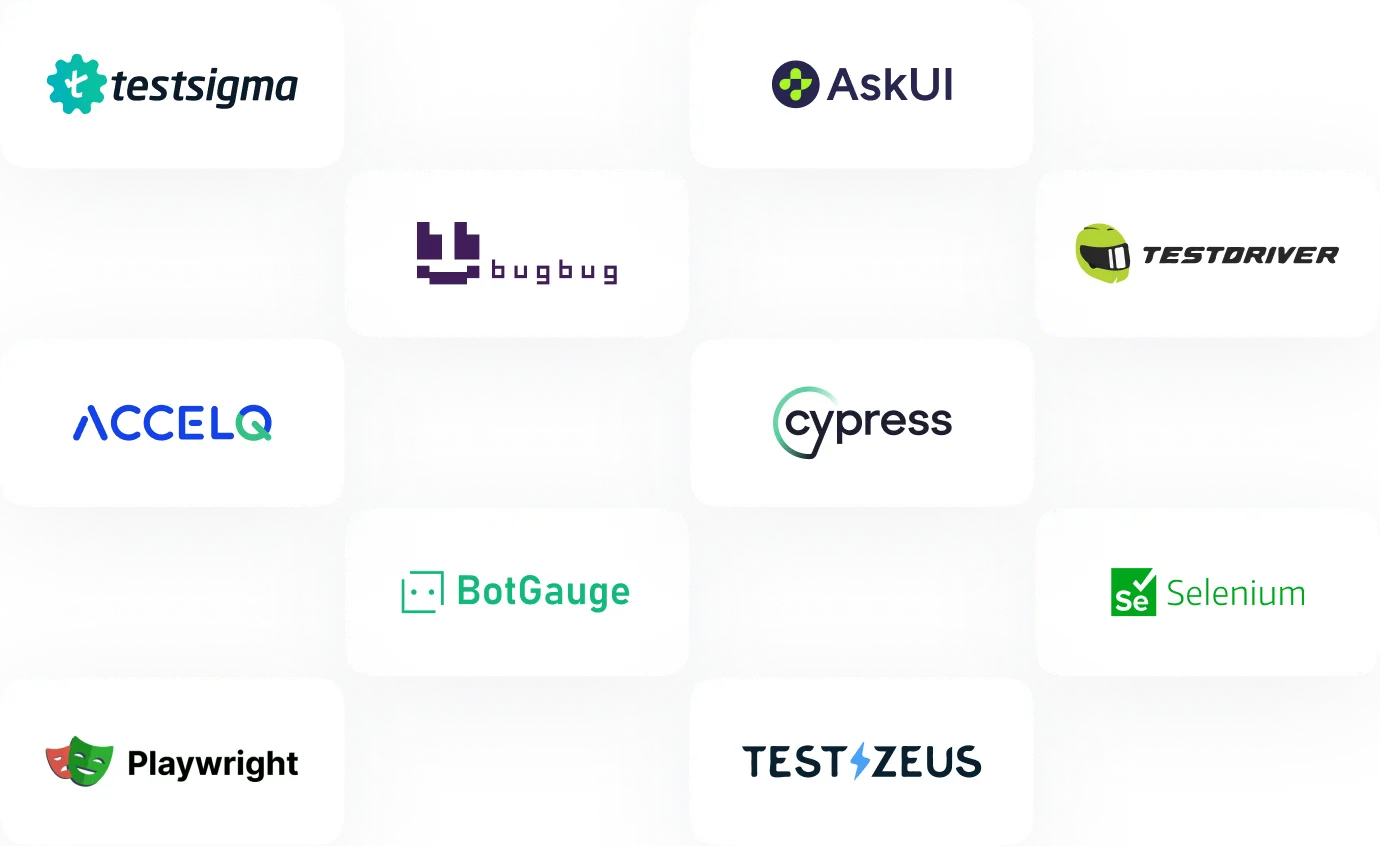Topics

UI testing tools empower teams to automate user interface validation, making them critical for ensuring web apps are reliable and user-friendly. Whether testing complex user flows or simple screens, modern UI testing frameworks and automated UI testing tools help deliver seamless experiences, reduce manual effort, and uncover bugs early.
Summarize this article with AI:
Comparison of the 5 Best UI Testing Tools
| Tool | Description | Key UI Testing Features |
|---|---|---|
| Cloud-based, Agentic AI-powered platform for web, mobile, desktop, API, SAP, and Salesforce test automation. | No-code interface, AI-based test creation, cross-platform automation, parallel testing, Self-healing maintenance, advanced reporting, and CI/CD support. | |
| Selenium | Widely-used open-source web UI automation library. | Cross-browser testing, multi-language support, extensive plugin ecosystem, and parallel execution via Grid. |
| Accelq | AI-based codeless automation for web, mobile, and desktop UIs. | Intelligent element recognition, composite UI controls, model-based test building, CI/CD integrations, and self-healing scripts. |
| Cypress | JavaScript-centric, developer-focused UI testing framework. | Live execution, auto-waiting, real-time debugging, API stubbing, cross-browser support, time-travel debugging. |
| Playwright | Modern automation framework for multi-browser UI testing. | Cross-browser testing, multiple language bindings, headless mode, live debugging, and network interception. |
12 Best UI Testing Tools in 2025
Testsigma
Testsigma is a cloud-based, Agentic AI-powered test automation platform for web, desktop, mobile, API, SAP, and Salesforce applications. With Testsigma’s intuitive no-code interface, NLP Engine, and advanced AI, both tech and non-tech team members can have control over complex UI test flows.

Features
- Testsigma Copilot and Atto for Agentic test automation
- No-code UI test cases creation in simple English.
- Cross-platform automation (web, mobile, API, desktop, Salesforce, SAP)
- AI-powered self-healing tests to reduce test maintenance
- Dynamic, customizable reports
- Built-in bug reporting, screenshot/video logging
- CI/CD pipeline integration for continuous testing
- Supports visual testing
Pros Testsigma
- Requires no coding
- Advanced reporting and analytics
- Accessible for both tech and non-tech members
- Integrates easily with common CI/CD tools
Cons Testsigma
- Primarily cloud-first, local testing is limited
BugBug
BugBug offers codeless, end-to-end UI testing for web apps, emphasizing simplicity and efficiency. Its Chrome-based recording, browser-based playback, and team-friendly features make it popular with SaaS and e-commerce businesses.

Features
- No-code browser-based test recording and playback
- Smart selectors, automatic waiting, parallel cloud runs
- Scheduled monitoring with notifications (email, Slack)
- Unlimited free users, PDF reporting
- CI/CD API and Zapier integration
Pros BugBug
- Highly accessible for non-technical users
- Unlimited tests/local runs on the free plan
- Easy collaboration for teams
Cons BugBug
- Best suited for web apps, not mobile/desktop
- Limited flexibility for highly complex test logic
TestDriver.ai
TestDriver.ai uses AI agents to create and maintain UI tests without selectors, delivering autonomous end-to-end UI testing for web and desktop. The tool adapts to UI changes in real time and integrates with GitHub workflows.

Features
- Autonomous, selectorless test generation and maintenance
- Natural language prompts for custom scenarios
- Exploratory and regression testing with screen replays
- Pull request-based test integration, dashboard reporting
- CI/CD integration with GitHub Actions, Vercel, and Netlify
Pros TestDriver.ai
- Adapts rapidly to changing UIs
- Easy onboarding, fast coverage
Cons TestDriver.ai
- Less transparent for manual test customization
- Primarily focused on web/desktop, mobile testing is limited
AskUI
AskUI automates UI testing using visual AI rather than code selectors, making it platform-agnostic. It interacts like a human, identifying elements visually and simulating clicks, swipes, or drags.

Features
- AI-based interaction for desktop, web, or mobile UIs
- Compatible with any OS or tech stack
- Customizable testing with JavaScript and Typescript SDKs
- Screenshot capture, detailed debugging
- Integrations with test runners (e.g., Jest, vitest)
Pros AskUI
- No reliance on DOM selectors, works across platforms
- Flexible, readable API
- Handles complex UI tasks like drag-and-drop
Cons AskUI
- Early-access phase
- Initial setup requires code permissions
Hercules
Hercules by TestZeus is an open-source, AI-driven agent for autonomous UI, API, and visual testing. It uses Gherkin-format scripts and AI for self-healing and end-to-end automation, optimized for Salesforce and browser-based interfaces.

Features
- Autonomous agent-based UI testing; zero code/maintenance
- Gherkin input, auto-execution, standard reporting
- Visual validation, accessibility, and security checks
- Parallel cloud/browser farm runs, mobile emulation
- CI/CD (Docker-native), network log/video recording
Pros Hercules
- Open-source, flexible for advanced custom workflows
- Strong visual validation and reporting
- Self-healing and agentic test flows
Cons Hercules
- Focused chiefly on web and Salesforce environments
- Complex custom scenarios may require adjustments
LELANTE
LELANTE is an LLM-powered framework for fully automated Android UI testing, translating natural language cases directly into UI actions. It emphasizes scalability and adaptability for evolving apps.

Features
- Natural language test input for Android apps
- Automatic prompt engineering and GUI refinement
- Live action and test execution via LLMs
- 73% real-world test execution success (2025 benchmark)
Pros LELANTE
- Removes manual scripting requirements for Android testing
- Scales easily with app complexity
Cons LELANTE
- Early-stage framework, limited multi-platform support
BotGauge
BotGauge is a Gen AI-powered tool for rapid, low-code UI, functional, API, and visual test automation. It supports English language test creation, intelligent scenario suggestions, and smart analytics for QA optimization.

Features
- Low-code, English-natural test scripting
- Gen AI authoring for scenarios, self-healing test management
- Parallel testing, DB/API visual testing
- Smart release analytics and CI/CD integrations
- Unlimited team seats per license
Pros BotGauge
- Scales across web, API, and database testing
- Substantial cost and manual intervention reductions
- Early bug detection and self-healing
Cons BotGauge
- Mobile support in development, not yet available
- Some advanced cases require custom APIs
UIValidate
UIValidate focuses on robust, no-code validation of web and desktop UIs, merging test management and analytics to simplify coverage and reporting.

Features
- No or low-code GUI test creation
- Comprehensive reporting, analytics, and debugging
- Cross-platform compatibility
- Third-party integrations (CI/CD, DevOps tools)
Pros UIValidate
- Easy for beginners and business testers
- Automates tedious coverage tasks
Cons UIValidate
- May be feature-limited for complex, multi-layered apps
ACCELQ
ACCELQ delivers AI-powered codeless UI testing for web, mobile, desktop, and APIs, enabling teams of varying skill levels to build, maintain, and execute end-to-end test flows.

Features
- No-code automation for modern UI stacks (React, Angular, Flutter)
- Composite control support (Kendo, Bootstrap)
- Model-based testing, auto-generated test assets
- Self-healing object recognition
- Deep CI/CD tool integrations (JIRA, Jenkins, Bamboo, TFS)
Pros ACCELQ
- Unified platform for all test types
- Self-maintaining scripts minimize maintenance
- Supports modern web stacks
Cons ACCELQ
- Slight learning curve for non-technical users
- Performance may vary with very large suites
Selenium
Selenium is the classic open-source library for browser-based UI automation; it’s favored for its flexibility and language support.

Features
- Cross-browser and OS support
- Multi-language bindings: Java, Python, C#, Ruby
- Selenium Grid for distributed parallel testing
- Integration with frameworks like Appium for mobile testing
Pros Selenium
- Mature, widely documented, massive community
- Highly customizable with plugins
Cons Selenium
- No-code support is limited
- Lacks built-in reporting and analytics
Playwright
Playwright is a fast-growing automation UI testing framework built for reliable cross-browser web testing. Its robust debugging, headless execution, and multi-language support make it a top pick for modern teams.

Features
- Out-of-process test execution for performance
- Supports Chrome, Firefox, Safari, Edge, mobile emulation
- Network interception, advanced debugging
- UI mode, Inspector, trace viewer
Pros Selenium
- Fast, reliable, cross-browser
- Developer-friendly tools
Cons Selenium
- Visual test automation relies on third-party tools
- Native mobile support requires integration
Cypress
Cypress provides JavaScript-based automation for web UI testing, focused on developer ergonomics and debugging.

Features
- Auto-waiting, live reloads, time-travel debugging
- Stubs/API control for complete test scenarios
- Fast execution, paid coverage reporting
Pros Cypress
- Excellent live debugging and API testing
- Easy to set up and extend
Cons Cypress
- No support for native mobile apps
- Only major Chromium browsers natively supported
Factors to Consider While Choosing the
Best UI Testing Tool
- Application Type: Choose a tool that matches your specific platform, whether it’s web, mobile, or desktop, to ensure full coverage and smooth integration with your app’s environment.
- Programming Language and Tech Stack Support: Select a tool that supports your team’s languages and frameworks so you can use existing skills and avoid compatibility issues.
- Ease of Use: Pick no-code or codeless solutions for easier test creation, especially if business users or manual testers contribute to automation.
- Cross-browser and Cross-platform Compatibility: Make sure tests run consistently on all major browsers and operating systems, so users have a reliable experience everywhere.
- Reporting, Analytics, and Debugging Capabilities: Look for tools offering clear reports and debugging aids, such as video logs, screenshots, and traceability, to help identify and resolve issues quickly.
- Integration with CI/CD Pipelines and DevOps Tools: Use tools that connect with your CI/CD workflows for automated, fast feedback on every software update or release.
- Community Support and Documentation: A tool with strong community and documentation means help is easy to find and onboarding is simpler, reducing learning time.
- Budget, Licensing, and Scalability Considerations: Check costs, free and paid options, and scalability to ensure the tool can grow with your team or project.
- Test Maintenance and Self-healing Capabilities: Prefer tools with self-healing or easy updates so you spend less time fixing broken scripts as your UI changes.
- Support for Advanced Test Scenarios: Choose a solution with visual, accessibility, and security test options if your app needs to meet strict standards or reach diverse
Conclusion
UI testing tools play a pivotal role in enabling teams to deliver reliable and user-friendly web applications. With evolving technologies, tools that offer codeless interfaces, AI-powered self-healing, comprehensive reporting, and seamless CI/CD integrations are becoming essential. As UI complexity grows, investing in a flexible and scalable automation platform can significantly reduce manual effort and speed up release cycles. To explore a powerful solution that combines these capabilities, try Testsigma for automated UI testing.

Frequently Asked Questions
